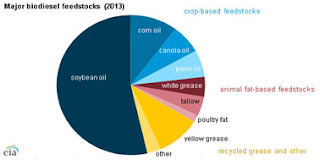By Mr. Ajaya Sharma, Director, Rnk Agro & Chemicals Pvt. Ltd.
•
The RISING cost
and DECLINING availability of starch as a Consumption of energy is on rapid
rise (Graph A) AND The World Energy Production Estimates are Declining (Graph
B)
GRAPH-A GRAPH-B
•
Energy costs will continue to drive grain prices, as more grain is diverted
towards bio-fuel production, impelled by high crude oil prices. It is evident
from Graph C that more and more grains like Soybean, Corn etc are
converted into oil for Bio diesel conversion.
Graph C
Non starch
Polysaccharides (NSP)-wheat, barley
and rye contain high concentration of NSP. Digestion of saturated fatty acids (SFA)
are affected more than that of Unsaturated fatty acids (USFA)(Danicke,2001) due
to viscosity increase caused by NSP. In turn, the gut motility and rate of
passage is affected which affects Enzymes & micro flora. Furthermore,
soluble NSP may stimulate microbial growth in the small intestine (Annison and Choct, 1991) when diets with high level of NSP are ingested. Poor digestion may
result due to low concentration of bile salts in diets fed with high NSP levels
(Smits and Annison, 1996)
Similarly, energy derived
from DDGS is also not appropriate for modern breeds wherein in some parts of
the world 28 day old broilers are culled and now aiming to reduce further to 25
days. The greatest challenge posed by DDGS energy is more or less same as in NSP.
Another popularly used
ingredient is Rice polish, which is again not perfect alternative for
energy source due to inherent problems such as, hydrate rancidity, oxidative
rancidity, high phytate content, enzyme inhibitors, high fiber content, low
digestibility in chicks, hull adulteration and very low keeping quality
Whereas, Fatty acids,
stored as TGL in an organism, are an important source of energy.
The energy yield from
a gram of fatty acids is approximately 9 kcal (37 kJ),
compared to 4 kcal/g (17 kJ/g) for carbohydrates. Carbohydrates are highly
hydrated;1 g of glycogen can bind approximately 2 g of WATER, which
translates to 1.33 kcal/g (4 kcal/3 g). If relied on carbohydrates to store
energy, then it would be 1:6.75 (fat: Carbohydrate) ratio or we can say the
energy stored by 1 kg of fat would take 6.735 Kg. of Carbohydrates to provide
the same. If the human body relied on carbohydrates then a person need to carry
31 kg (67.5 Lb.) of hydrated glycogen to have the energy equivalent
to 4.6 kg (10 lb.) of fat. Fatty acids are hydrophobic
(Water repellant). Thus, Fatty acids can
be stored in a relatively anhydrous (water-free) environment.
Hibernating animals are a good example for utilizing fat reserves as
fuel. Bears hibernate for about 7 months.
Though in great demand,
Grains increases dietary costs and reduces margins and/or reduced feed
efficiency. Next Best option , is to use supplemental fats to increase dietary
energy content.
Fats are used around the
globe as a supplemental dietary energy source in poultry diets to yield higher
levels of ME.
Graph D
Globally Fat
consumption for human needs is equally on the rise as evident from the Graph
D above. Demand Scenario of edible oils in India up to 2025 states-as per Dr. B.V.
Mehta-Exe.director Solvent Extractors Association of India (SEA), due to high
growth in income levels, increasing trend in spending & better living
standards; India promises to continue high growth in consumption of edible oils
and consumption may reach 27.8 million ton by 2025 from the present level of
17.5 million ton @3% growth per annum. See Graph E-Demand/Consumption of edible
oils in India- projection up to 2025-
GRAPH E
There exists a huge
shortfall between local production and demand of oil and fats in India. For the
year 2012-13 consumption was 17.3 million ton that left a gap of 10 million ton
between demand and supply which is bridged by imports leading to surge in
prices of International vegetable oils. As shown in graph below-edible oil
production and demand and supply gap as shown in GRAPH-F
GRAPH-F
Thus inedible vegetable
fats –with high free fatty acid contents- could be used as an alternative to
fresh extracted vegetable oils which are increasingly being in demand for human
consumption leading to rise in prices.
Hitherto these inedible
oils were being used for soap making or for crude refining- which are being
sold to unscrupulous street vendors for cooking ad frying.
These inedible oils pose a
great challenge as they are easily rancid prone and not suitable for long
storage.
With improved technologies
available, the blenders are able to stabilize such oils and with scientific
blending at controlled environment and temperatures mixed with anti oxidants to
make them available for animal feed usage.
It is our endeavor to
educate prospective buyers on the suitability of Fat as a most appropriate
source to fulfill shortfall of Dietary Feed energy requirement
References:
1.
Danicke,S. (2001)
Interaction between cereal identity and fat quality and content in response to
food enzymes in broilers in M.R.Bedford & Partridge, G.G. (Eds.) Enzymes in
Farm Animal Nutrition.
2.
Annison, G. and
Choct, M.(1991). Anti nutritive activities of cereal non-starch polysaccharides
in broiler diets and strategies minimizing their effects. World’s poultry
science journal, 47.
3.
Smits. C.H.M. and
Annison, G. (1996). Non starch plant polysaccharides in broiler nutrition
–towards a physiologically valid approach to their determination. World’s
poultry science journal, 52.
4.
Mehta,
Dr.B.V., Director, The Solvent extractors association of India, delivered a
lecture on “India’s demand supply of edible oils with special reference to
Scope for sustainable Palm oil in India” Workshop organized by Global Canopy
Programme & UN-ORCID, Jakarta, Indonesia, Feb.17th 2014.






Blended fat is the ultimate choice
ReplyDelete